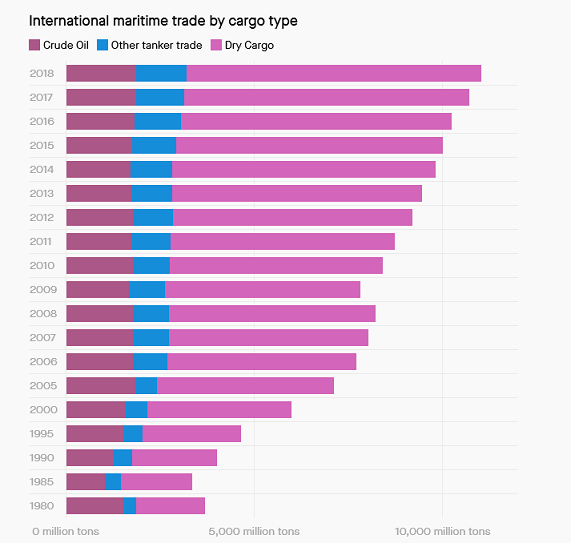Home
| About
| Mine Tracker
| RSS
| Footer
▄▄▄▄▄▄▄▄▄▄▄▄▄▄▄▄▄▄▄▄▄▄▄▄▄▄▄▄▄▄▄▄▄▄▄▄▄▄▄▄▄▄▄▄▄▄▄▄▄▄▄▄▄▄▄▄▄▄▄▄▄▄▄▄▄▄▄▄▄▄▄▄▄▄▄▄▄▄▄▄▄▄▄▄▄▄▄▄▄▄▄▄▄▄▄▄ █▄▄░▄▄█░▄▄▀█░▄▄▀█▀▄▀█░▄▄███░▄▄▀█░▄▄▀█░▄▀███▄▄░▄▄█░▄▄▀█░▄▄▀█▀▄▀█░▄▄█░▄▄▀█░▄▄▀██▄██░███▄██▄░▄█░██░ ███░███░▀▀▄█░▀▀░█░█▀█░▄▄███░▀▀░█░██░█░█░█████░███░▀▀▄█░▀▀░█░█▀█░▄▄█░▀▀░█░▄▄▀██░▄█░███░▄██░██░▀▀░ ███░███▄█▄▄█▄██▄██▄██▄▄▄███▄██▄█▄██▄█▄▄██████░███▄█▄▄█▄██▄██▄██▄▄▄█▄██▄█▄▄▄▄█▄▄▄█▄▄█▄▄▄██▄██▀▀▀▄ ▀▀▀▀▀▀▀▀▀▀▀▀▀▀▀▀▀▀▀▀▀▀▀▀▀▀▀▀▀▀▀▀▀▀▀▀▀▀▀▀▀▀▀▀▀▀▀▀▀▀▀▀▀▀▀▀▀▀▀▀▀▀▀▀▀▀▀▀▀▀▀▀▀▀▀▀▀▀▀▀▀▀▀▀▀▀▀▀▀▀▀▀▀▀▀▀
Article: Net Zero Shipping
https://www.ship-technology.com/features/net-zero-shipping-where-theres-a-will/
Shipping emissions come down to four factors: the weight of goods transported, the distance they cover, the amount of fuel it takes for one tonne of products to move 1km, and the amount of the carbon released through the production and use of that fuel – known as the fuel’s “carbon intensity”. Although battery electric ships are in development for short-distance shipping, the overwhelming focus for decarbonising the sector as a whole comes down to that last point – the type of fuel used and its carbon intensity. The problem is, zero-emissions fuels like green hydrogen and ammonia have yet to enter the fuel supply and are not expected to be produced in sufficient quantities to grow past the single-digit percentage mark before 2030 at the earliest.
https://www.ship-technology.com/features/net-zero-shipping-where-theres-a-will/
Shipping emissions come down to four factors: the weight of goods transported, the distance they cover, the amount of fuel it takes for one tonne of products to move 1km, and the amount of the carbon released through the production and use of that fuel – known as the fuel’s “carbon intensity”. Although battery electric ships are in development for short-distance shipping, the overwhelming focus for decarbonising the sector as a whole comes down to that last point – the type of fuel used and its carbon intensity. The problem is, zero-emissions fuels like green hydrogen and ammonia have yet to enter the fuel supply and are not expected to be produced in sufficient quantities to grow past the single-digit percentage mark before 2030 at the earliest.
Forty percent of all shipping cargo consists of fossil fuels
https://qz.com/2113243/forty-percent-of-all-shipping-cargo-consists-of-fossil-fuels

Cargo ships schlep thousands of millions of tons of cargo around the world every year, belching out 3% of the world’s greenhouse gas emissions as they traverse the seas. But the real damage is done by the contents of their holds. By weight, 40% of maritime trade consists either of fossil fuels on their way to be burned or of chemicals derived directly from fossil fuels.
https://qz.com/2113243/forty-percent-of-all-shipping-cargo-consists-of-fossil-fuels

Cargo ships schlep thousands of millions of tons of cargo around the world every year, belching out 3% of the world’s greenhouse gas emissions as they traverse the seas. But the real damage is done by the contents of their holds. By weight, 40% of maritime trade consists either of fossil fuels on their way to be burned or of chemicals derived directly from fossil fuels.
Climate Trace
https://climatetrace.org/map

We harness satellite imagery and other forms of remote sensing, artificial intelligence, and collective data science expertise to track human-caused GHG emissions with unprecedented detail and speed. Climate TRACE’s emissions inventory is the world’s first comprehensive accounting of GHG emissions based primarily on direct, independent observation. Our innovative, open, and accessible approach relies on advances in technology to fill critical knowledge gaps for all decision makers that rely on the patchwork system of self-reporting that serves as the basis for most existing emissions inventories.
https://climatetrace.org/map

We harness satellite imagery and other forms of remote sensing, artificial intelligence, and collective data science expertise to track human-caused GHG emissions with unprecedented detail and speed. Climate TRACE’s emissions inventory is the world’s first comprehensive accounting of GHG emissions based primarily on direct, independent observation. Our innovative, open, and accessible approach relies on advances in technology to fill critical knowledge gaps for all decision makers that rely on the patchwork system of self-reporting that serves as the basis for most existing emissions inventories.